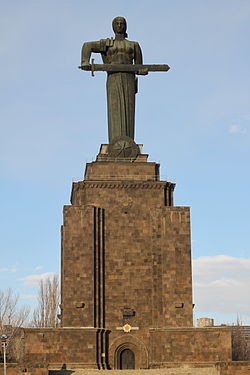- Mother Armenia
-
Mother Armenia Mother Armenia statue and the Military museumLocation: Victory Park, Yerevan, Republic of Armenia Elevation: 51 meters Founded: 29 November, 1950 Restored: 1967 Architect: Ara Harutyunian, Rafayel Israyelian Governing body: Ministry of Defence of Armenia Mother Armenia (Armenian: Մայր Հայաստան Mayr Hayastan) is the female personification of Armenia. Her most visual rendering is a monumental statue in Victory Park overlooking the capital city of Yerevan, Armenia.
Contents
History
The current statue replaces a monumental statue of Joseph Stalin that was created as a victory memorial for the second world war. During Stalin's reign of the Soviet Union, Grigor Harutyunyan, the first secretary of the Armenian Communist Party's Central Committee and members of the government oversaw the construction of the monument which was completed and unveiled to the people on November 29, 1950. The statue was considered a masterpiece of the sculptor Sergey Merkurov. The pedestal was designed by architect Rafayel Israyelian. Realizing that occupying a pedestal can be a short-term honour, Israyelian designed the pedestal to resemble a three-nave basilic Armenian church, as he confessed many years later "Knowing that the glory of dictators is temporary, I have built a simple three-nave Armenian basilic".[1] In contrast to the right-angled shapes of the external view, the interior is light and pleasing to the eye and resembled Echmiadzin's seventh-century St. Hripsime Church.
In spring 1962, the statue of Stalin was removed, with one soldier being killed and many injured during the process, and replaced by the Mother Armenia statue, designed by Ara Harutyunyan.
"Mother Armenia" has a height of 22 meters, thus making the overall height of the monument 51 meters, including the pedestal. The statue is built of hammered copper while the pedestal-museum is of basalt.[2]
Symbolism
The Mother Armenia statue symbolises peace through strength. It can remind viewers of some of the prominent female figures in Armenian history, such as Sose Mayrig and others, who took up arms to help their husbands in their clashes with Turkish troops and Kurdish irregulars. It also recalls the important status and value attributed to the older female members of an Armenian family.
Its strategic location on a hill overlooking Yerevan makes it look like a guardian of the Armenian capital. Every year on 9 May, thousands of Armenians visit the statue of Mother Armenia and lay flowers to commemorate the Armenian martyrs of the World War II. The pedestal hosts the Mother Armenia Military Museum of the Ministry of Defense. When first built, it was a military museum dedicated to the World War II. Now a large proportion of the exhibition space is devoted to the Nagorno-Karabakh War of the 1980-90s. There are personal belongings, weapons and documents of the heroes, and walls are decorated with their portraits. There is a historical map on which Armenian forces worked for the capture of Shusha, among other historical artifacts.
See also
References
Coordinates: 40°11′42.90″N 44°31′29.34″E / 40.19525°N 44.5248167°E
National personifications - Argentina: Effigies of Argentina
- Armenia: Mother Armenia
- Brazil: Efígie da República
- Cambodia: Preah Thong and Neang Neak
- Canada: Johnny Canuck
- Finland: Finnish Maiden (Suomi-neito)
- France: Marianne
- Georgia: Kartlis Deda
- Germany:
- Greece:
- Iceland: Lady of the Mountain
- India: Bharat Mata
- Indonesia: Ibu Pertiwi
- Ireland:
- Israel: Srulik
- Italy: Italia Turrita
- Japan: Amaterasu
- Malaysia: Ibu Pertiwi (East Malaysia)
- Netherlands: Netherlands Maiden
- New Zealand: Zealandia
- Norway: Ola Nordmann
- Pakistan: Pak Watan
- Philippines:
- Juan dela Cruz
- Maria Clara
- Poland: Polonia
- Portugal:
- Russia: Mother Russia
- Spain: Hispania
- Sweden: Mother Svea
- Switzerland: Helvetia
- Ukraine: Cossack Mamay
- United Kingdom:
- United States:
/ Johnny Reb (southern states)
Categories:- National personifications
- Buildings and structures in Yerevan
- Monuments and memorials in Armenia
- Monuments and memorials built in the Soviet Union
- Colossal statues
- Sculptures in the Soviet Union
- History of Soviet Armenia
Wikimedia Foundation. 2010.

